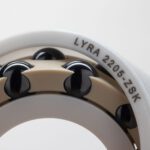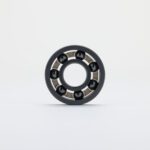We have already analyzed the importance not only of the choice of lubricant to be used in a bearing but also of maintenance operations.
Sometimes, however, the correct choice of lubricant or carrying out the appropriate maintenance operations are very difficult or impossible; for example:
- bearings with seals: restoring the right amount of lubricant requires disassembling the bearing from the machine or system, removing the seals, thoroughly washing the bearing, re-greasing, fitting new seals and reassembling the bearing in the machine or system
- bearings used in aggressive environments for the lubricant such as machines or plants for the food sector. The sanitation cycles that must periodically be carried out also involve the use of high pressure fluids. As a result of this pressure, the lubricant present inside the bearings could be removed during the operation or contaminated with the products used for sanitization
- bearings placed in humid environments or in the presence of steam: the lubricant can be contaminated and lose its effectiveness in a very short time
- bearings for high or very high temperature environments: for these conditions of use, the supply of lubricants can be very limited and with extremely high costs
The result of situations like these is that the bearings do not operate in optimal conditions, causing them to be replaced prematurely. Frequent maintenance operations lead to machine downtime which may not be economically acceptable.
The 5 characteristics of full ceramic bearings
A solution to all these problems is represented by full ceramic bearings, i.e. bearings made with:
- Rings in Zirconium Oxide (ZrO2) or Silicon Nitride (Si3N4)
- Rolling elements in Zirconium Oxide (ZrO2) or Silicon Nitride (Si3N4)
- PEEK, PTFE (Teflon) or PA66 (nylon) plastic cage obtained by molding or machining (the choice of material depends on the operating conditions of the bearing)
- Non-sliding seals in PEEK or PTFE (the choice of material depends on the operating conditions of the bearing).
The characteristics of full ceramic bearings which, in relation to the problem of lubrication, make them a very interesting solution, sometimes the only one, are listed below:
1. Hardness
The hardness of ceramic materials is, due to the intrinsic characteristics of this type of material, much higher than the hardness that steels for bearings reach after hardening.
2. Roughness
Rolling elements and rings made of ceramic material have a lower roughness than that obtainable with bearing steels.
3. Coefficient of friction
The coefficient of friction of ceramic materials is lower than the coefficient of friction of steels for bearings.
4. Resistance to temperature
Ceramic materials exhibit extremely high temperature resistance. In fact, Zirconium Oxide can be used up to 500 °C and Silicon Nitride up to 800 ° C while bearing steels, unless special treatments, can be used up to 150 °C.
5. Chemical resistance
Zirconium Oxide and Silicon Nitride are chemically inert against many chemicals that are fatal for steel bearings (acids, bases, organic compounds, water, salt spray, etc.).
The characteristics listed above give a very important advantage to full ceramic bearings: wear resistance is better than that of steels.
Let’s see why.
Let’s consider two bearings, one made of steel and the other one of ceramic material, of the same size and operating under the same load.
Wear is mainly caused by two effects: mechanical abrasion and temperature rise.
Since mechanical abrasion is linked to the roughness of the surfaces in contact, in ceramic materials this phenomenon will have less relevance because the roughness is lower than that obtainable in steel bearings.
The temperature rise in the ceramic bearing will be lower than that of the steel bearing. In fact, since ceramic materials have a higher hardness than steels for bearings, the contact surface between the rolling element and the race in the full ceramic bearing will be smaller than that present in the steel bearing. A smaller sliding surface associated with a lower coefficient of friction results in less heat generated.
Ultimately, the ceramic bearing shows a higher wear resistance than the steel bearing.
All this leads to an extremely important result: full ceramic bearings can operate under lubrication conditions that are impossible for steel bearings.
Some examples of use can be the following:
- Presence of high or very high temperatures: it is a very difficult situation for a steel bearing, not only due to the influence that the temperature has on the steel itself, but also because there may not be suitable lubricants. A full complement all ceramic bearing can also operate without lubrication.
- Machines or systems for the food sector: the regulations require the use of certified lubricants for food use. The general trend, however, is to eliminate all sources of contamination and, therefore, to use “natural” lubricants or to completely eliminate lubrication. In these conditions it becomes very difficult to use steel bearings. Conversely, full ceramic bearings can be lubricated with water or used without lubrication
- High vacuum applications: Steel bearings for this sector must adopt very special lubrication solutions to prevent the lubricant from gassing. The full ceramic bearing can operate without lubrication, thus representing a valid solution to this problem.



